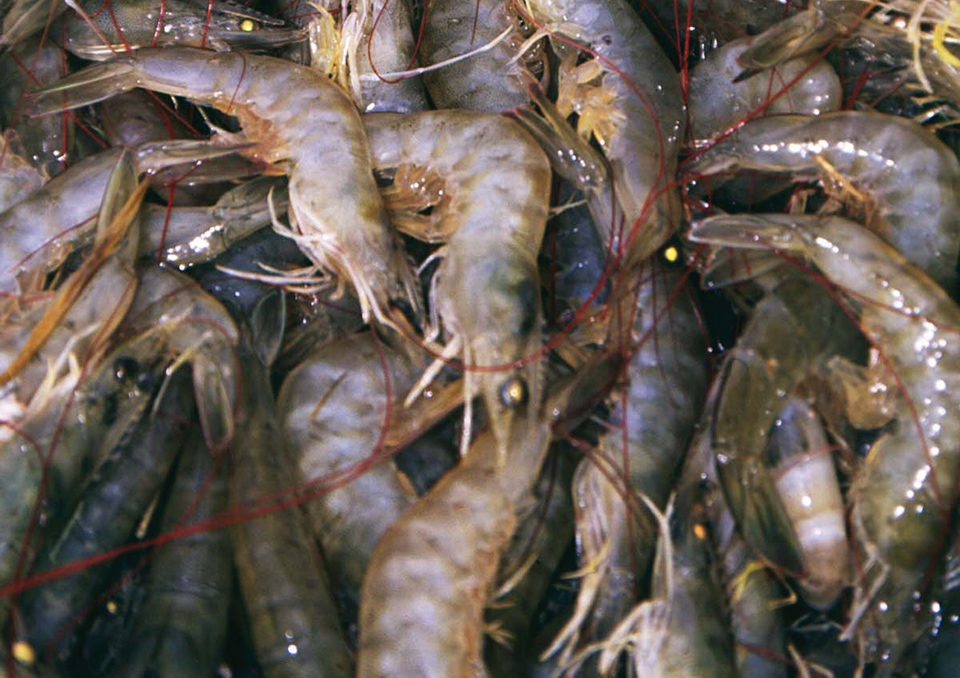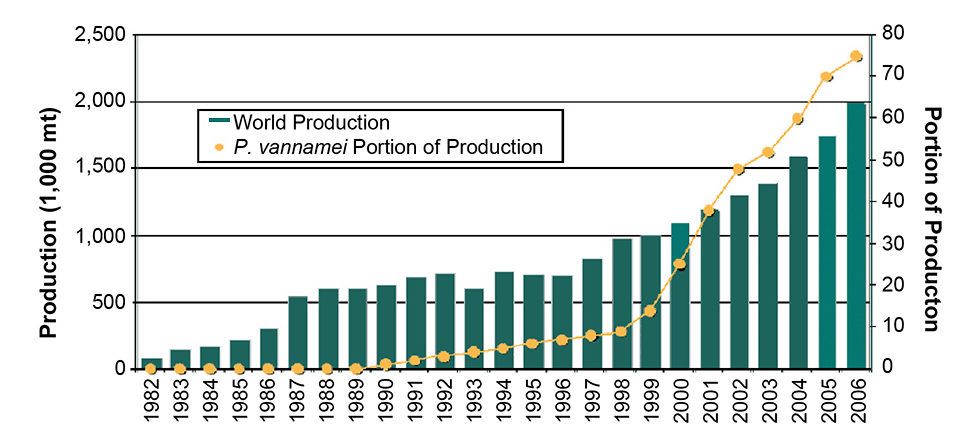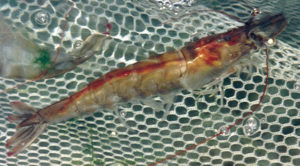Faster growth and disease resistance fuel a worldwide phenomenon

Shrimp farming has a long and colorful history whose development can be divided into three distinct periods: Start-Up Era, Hatchery Era and Breeding Era. Key characteristics of these periods are summarized in Table 1 and Fig. 1.
Wyban, Characteristics of shrimp-farming, Table 1
| Era | Years | Annual Production (x 1,000 mt) Start | Annual Production (x 1,000 mt) Finish | Growth Rate Gain | Growth Rate (%/Year) |
|---|---|---|---|---|---|
| Start-Up | 1982-87 | 84 | 604 | 520 | 103% |
| Hatchery | 1988-96 | 604 | 693 | 89 | 2% |
| Breeding | 1997-present | 693 | 2,000 | 1,307 | 21% |

Start-up era
During the Start-up Era of the 1980s, nearly all stocking material was wild postlarvae gathered from the sea. In Asia, farms raised primarily black tiger shrimp (Penaeus monodon), while in the Western Hemisphere the industry used Pacific white shrimp (P. vannamei). During this era, annual production increased over 100 percent per year. Growth was driven by the combination of very strong market acceptance and demand for farmed shrimp, and a relative absence of disease that allowed simple pond culture methods to succeed.
Hatchery era

During the 1988-1996 Hatchery Era, postlarvae (PL) were produced in land-based hatcheries. While cultured, these PL were genetically wild animals because the parents were collected in the sea. Shrimp farming in the West was dominated by P. vannamei production, while Asian farming was dominated by P. monodon.
Asian shrimp production was at least five times greater than Western production throughout this era, so production statistics were dominated by P. monodon. Total world production rose from 604,000 to 693,000 metric tons (MT), with an average annual gain of only 2 percent.
The main obstacle to growth was widespread shrimp disease that moved through the industry with the hatchery-produced PL, because the hatcheries paid little attention to animal biosecurity. Diseases carried by wild broodstock were passed to the PL offspring in the hatcheries, then introduced to farms when the PL were stocked.
The other obstacle to growth was the continued reliance on wild animals. During this period, shrimp farming production reached an effective “carrying capacity” for the use of wild shrimp. While farmers tried to use higher stocking densities to increase yields and profits, their wild animals – which often carried disease – were not well suited to intensive culture systems.
Breeding era
The Breeding Era, from 1997 to the present, saw a resumption of growth, which jumped to more than 20 percent per year for more than 10 years. This rapid industry growth was primarily driven by the domestication, breeding, and worldwide spread of P. vannamei from the West into Asia. World shrimp farming production using P. vannamei expanded from only 10 percent of total production in 1998 to 75 percent of total world production in 2006. Thailand’s shrimp revolution, characterized by the use of domesticated P. vannamei bred for faster growth and disease resistance, perhaps best illustrates the worldwide white shrimp phenomenon.
Economic impacts
The use of domesticated stocks has allowed farmers to continually refine their systems to optimize production economics based on market demands and pricing. Domesticated stocks have generally reduced disease episodes and the “gambling” nature of shrimp farming typical of earlier eras. Domestication has also allowed corporate investment in the industry and a general industry consolidation.
Because of the great increases in production resulting from the use of domesticated P. vannamei, shrimp farming is now suffering from its own success. Shrimp prices have declined substantially as a direct result of the tremendous gains in supply.
Viral resistance
Development of specific pathogen-free (SPF) P. vannamei in the United States in the early 1990s led to dramatic increases in U.S. shrimp farming production. Following initial production trials, the entire U.S. shrimp industry was stocked in 1992 with PL derived from SPF P. vannamei broodstock cultured in Hawaii. Production doubled as a direct result of this innovation and persisted through 1995.
But by 1996, Taura Syndrome Virus (TSV) marched through Central America and struck a deadly blow to the Texas, USA, industry, dropping production by 50 percent. While devastating to farmers, this disaster was the second major event in the history of P. vannamei domestication – U.S. shrimp farmers asked researchers to develop shrimp resistant to this virus. While many scientists were skeptical that virus resistance could be achieved using selective breeding, several groups initiated programs to do just that.
High Health Aquaculture, Inc., one of the world leaders in shrimp domestication and scientific breeding, initiated a breeding program to develop fast-growing, TSV-resistant P. vannamei in 1997. To date, 10 generations of selection have been completed.
High Health uses a combination of family and within-family selection and line-crossing to produce hybrid stocks that are both fast-growing and TSV-resistant. Its most advanced SPF stocks are now commonly used in Thailand and Indonesia.
Economics
Domestication and breeding of P. vannamei have significantly improved the economics and reliability of shrimp farming. The driving force in Asia’s switch to P. vannamei was based on the much higher profits achieved with P. vannamei compared to P. monodon (Table 2).
Wyban, Production parameters and profits, Table 2
| Parameter | P. monodon | P. vannamei | Difference |
|---|---|---|---|
| Density (PL/m2) | 40-50 | 120-200 | 300% |
| Crop duration (days) | 110-140 | 105-120 | 27% |
| Harvest size (g) | 22-28 | 21-25 | 5% |
| Yield (mt/ha/crop) | 8 | 24 | 300% |
| Crop value (U.S. $/ha) | $45,000 | $96,000 | 220% |
| Crop costs (U.S. $/ha) | $32,000 | $60,000 | 187% |
| Profit (U.S. $/ha) | $13,000 | $36,000 | 280% |
With the continuing decline in shrimp prices caused by increased supply, farmers need to lower their costs of production. The biggest opportunity to lower costs is through the use of top-quality seedstock that carry high-performance genetics, are free of disease, and are cultured under optimum hatchery conditions to maximize their growth potential.
Domestication and breeding, and the subsequent adoption of P. vannamei in Asia added tremendous value to the world shrimp industry. During the Hatchery Era, the annual shrimp production of nearly 700,000 MT per year had a total crop value of about U.S. $3.5 billion, based on an average price of $5 per kilogram. Despite declining prices from increased supply, shrimp production today is worth more than $6.0 billion, based on a worldwide price of $3 per kilogram.
(Editor’s Note: This article was originally published in the July/August 2007 print edition of the Global Aquaculture Advocate.)
Now that you've finished reading the article ...
… we hope you’ll consider supporting our mission to document the evolution of the global aquaculture industry and share our vast network of contributors’ expansive knowledge every week.
By becoming a Global Seafood Alliance member, you’re ensuring that all of the pre-competitive work we do through member benefits, resources and events can continue. Individual membership costs just $50 a year. GSA individual and corporate members receive complimentary access to a series of GOAL virtual events beginning in April. Join now.
Not a GSA member? Join us.
Author
-
Jim Wyban, Ph.D.
High Health Aquaculture Inc.
P.O. Box 1095
Kurtistown, Hawaii 96760 USA[109,111,99,46,108,105,97,109,103,64,110,97,98,121,119,46,109,105,106]
Tagged With
Related Posts

Health & Welfare
Ammonia addition enhances microbial flocs in nursery phase for Pacific white shrimp
In a study, “pre-fertilization” in the nursery phase of a biofloc system for shrimp was tested. The objective was to accelerate the biofloc formation to minimize ammonia concentrations, avoiding high peaks during culture.

Aquafeeds
Automated feeding systems in pond production of Pacific white shrimp
Results of this study show that automated feeding systems are significantly more efficient than hand feeding in shrimp production ponds and that increases in feed input, application of adaptive technology and training of people to maintain the feeding system must all be considered.

Responsibility
A look at various intensive shrimp farming systems in Asia
The impact of diseases led some Asian shrimp farming countries to develop biofloc and recirculation aquaculture system (RAS) production technologies. Treating incoming water for culture operations and wastewater treatment are biosecurity measures for disease prevention and control.

Health & Welfare
Born in Hawaii, SPF broodstock shrimp industry faces globalization
The next step for shrimp breeding will be developing animals that aren’t just disease-free, but increasingly resistant to multiple pathogens. The industry is globalizing, with suppliers setting up shop overseas. But its birthplace will always be Hawaii.


